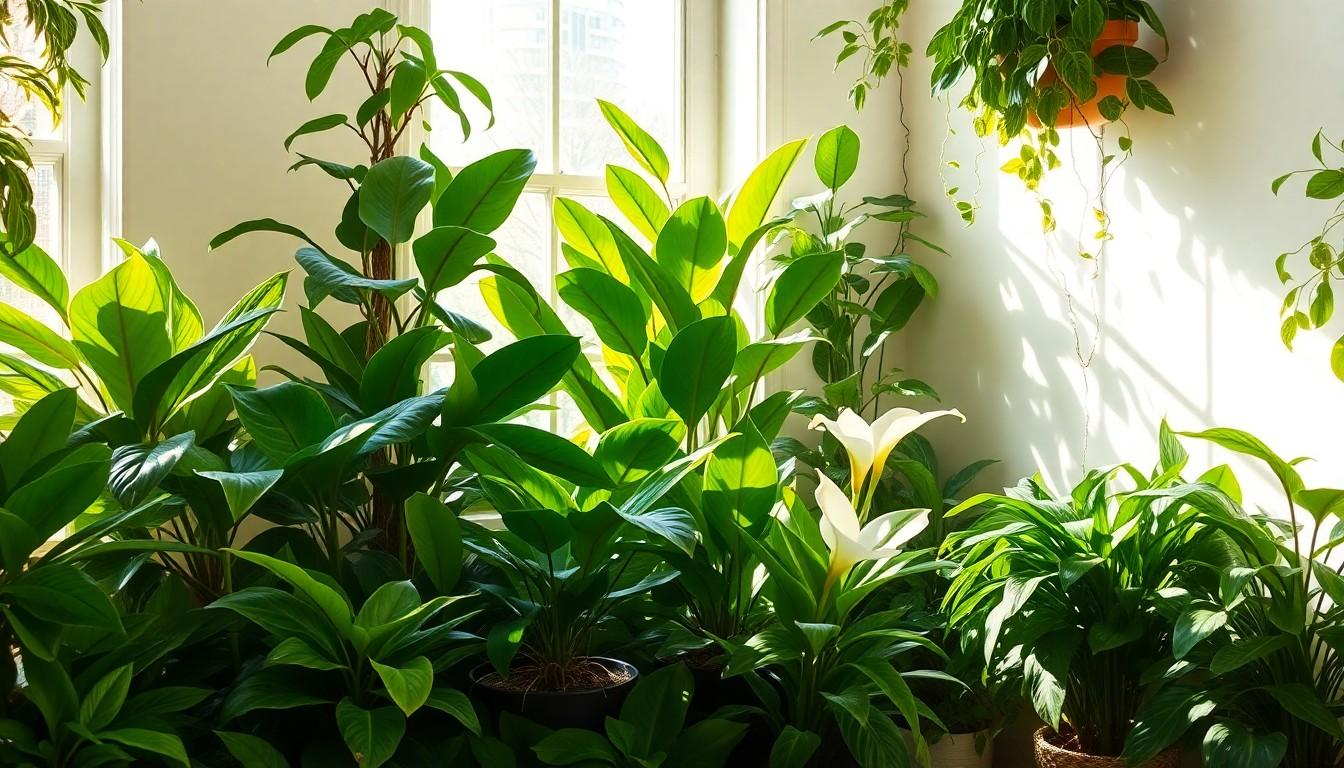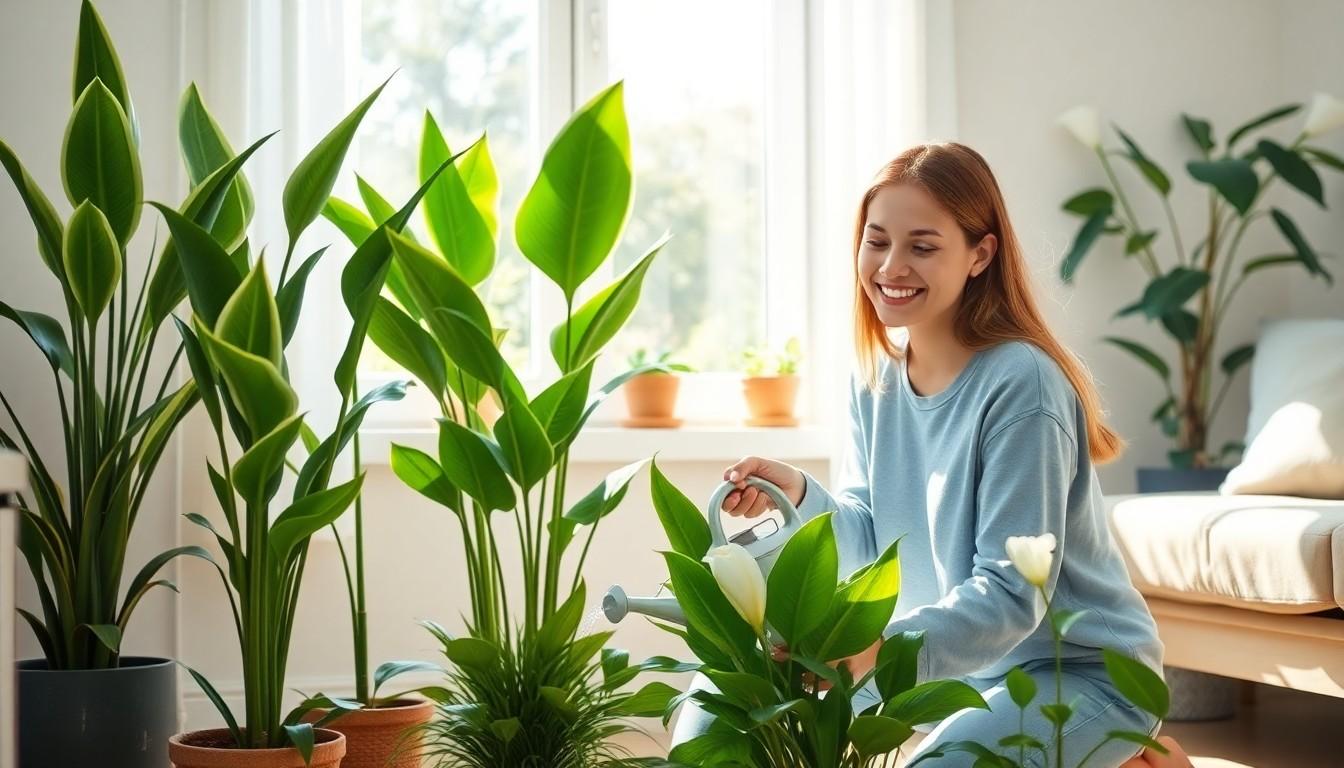Imagine walking into your home and taking a deep breath of fresh air, as if you just stepped into a lush forest. Indoor air purifying plants can make that dream a reality. Not only do these green wonders beautify your space, but they also work tirelessly to cleanse the air of toxins, creating a healthier environment. Who knew that adding a little greenery could turn your living room into a mini oxygen factory?
These leafy companions are like nature’s own air fresheners, minus the artificial scents and questionable ingredients. From the resilient snake plant to the charming peace lily, there’s a perfect plant for every personality. So why not let these botanical beauties do the heavy lifting? With a bit of humor and a touch of greenery, indoor air purifying plants can transform your home into a sanctuary of fresh air and good vibes.
Overview Of Indoor Air Purifying Plants
Indoor air purifying plants enhance air quality in spaces where people live and work. These plants absorb toxins and release oxygen, contributing to a healthier environment. Various plant species effectively reduce pollutants such as formaldehyde and benzene, making them popular choices.
Snake plants, also known as Sansevieria, thrive in low light and require minimal water. This hardy plant converts carbon dioxide into oxygen at night, improving air quality even after sunset. Peace lilies, featuring stunning white blooms, excel at filtering out harmful chemicals found in household cleaners.
Spider plants are renowned for their air-purifying abilities. They remove contaminants like xylene and carbon monoxide while producing oxygen. Additionally, they’re easy to care for and grow well in a range of lighting conditions.
Pothos can effectively eliminate indoor air toxins as well. Its trailing vines create a lush, vibrant atmosphere while improving air circulation. The ability to adapt to various environments makes pothos an excellent indoor plant choice.
Moreover, Boston ferns contribute to improved air humidity. They absorb moisture and toxins, making them beneficial for respiratory health. Many people appreciate their feathery fronds, adding a natural touch to any room.
Integrating these plants into indoor spaces encourages a sustainable lifestyle. Their aesthetic appeal enhances decor while promoting overall well-being. Placing a variety of air-purifying plants throughout the home creates a refreshing atmosphere for everyone.
Benefits Of Indoor Air Purifying Plants

Indoor air purifying plants offer numerous advantages, particularly in improving air quality and enhancing well-being.
Improved Air Quality
Indoor plants effectively absorb harmful toxins from the air. For instance, snake plants and peace lilies remove pollutants like formaldehyde and benzene. Such plants contribute to a significant reduction in airborne contaminants. Studies show that a few plants can enhance indoor air quality noticeably. It’s important to note that these plants also release oxygen during the day, creating a fresher atmosphere. Maintaining a few varieties can lead to considerable benefits for respiratory health. With consistent care, these green additions promote a healthier living space overall.
Enhanced Mood And Well-Being
Indoor plants positively impact mental health and well-being. Engaging with greenery often reduces stress and anxiety levels. Research indicates that the presence of plants can enhance mood and increase productivity. In homes filled with these purifying plants, individuals frequently report feelings of calmness and relaxation. Additionally, caring for plants offers a fulfilling routine that fosters a connection to nature. Vibrant foliage from plants like pothos and spider plants adds beauty, which can uplift spirits. Overall, integrating air purifying plants proves beneficial for both mental and emotional health.
Popular Indoor Air Purifying Plants
Several indoor plants effectively enhance air quality while adding visual appeal to spaces. The following plants are recognized for their air purifying properties.
Spider Plant
Spider plants stand out for their ease of care and resilience. They thrive in various light conditions and require minimal watering. These plants remove pollutants like formaldehyde and xylene from the air. A single spider plant can eliminate up to 90% of indoor toxins within 24 hours. Their arching green leaves with white stripes create an attractive aesthetic. Placing them in hanging baskets elevates their beauty significantly. Additionally, they produce baby plants, or “pups,” which allow for easy propagation.
Peace Lily
Peace lilies are favored for their striking white blooms and air purifying abilities. This plant excels in filtering harmful chemicals such as ammonia, benzene, and formaldehyde. It thrives in low light, making it perfect for indoor spaces. With proper care, peace lilies can bloom several times a year. Regular watering and occasional fertilization boost their growth. Their elegant appearance complements a wide range of decor styles, enhancing any living area. Peace lilies contribute to a healthier atmosphere, making them an excellent choice for home or office.
Snake Plant
Snake plants are popular due to their unique upright leaves and minimal care requirements. This plant effectively converts carbon dioxide into oxygen at night, providing benefits even during sleep. Snake plants can thrive in low light, making them suitable for various environments. Their natural ability to filter toxins helps maintain cleaner air. Additionally, these hardy plants require infrequent watering, making them ideal for busy individuals. With their vibrant green color and stripe patterns, snake plants enhance both visual appeal and air quality.
Care Tips For Indoor Air Purifying Plants
Maintaining indoor air purifying plants requires attention to several essential factors. Proper care enhances their effectiveness and the beauty they bring to living spaces.
Watering Requirements
Watering needs vary across plant species. Snake plants thrive on minimal water, requiring irrigation only when the soil dries out completely. In contrast, peace lilies prefer consistently moist soil; allowing it to dry can damage their foliage. Spider plants tolerate infrequent watering but benefit from a routine, ensuring their soil remains moderately damp. Regular inspections help determine moisture levels, promoting optimal growth and air purification.
Light Conditions
Light conditions significantly affect plant health. Peace lilies flourish in low light, making them ideal for shaded areas. Snake plants also tolerate low light but appreciate indirect sunlight for optimal growth. Spider plants prefer bright, indirect light, enhancing their ability to cleanse the air. Understanding each plant’s specific light preferences aids in maximizing their purifying power, ensuring a healthy indoor environment.
Soil Selection
Selecting the right soil supports robust growth. Well-draining soil is essential for snake plants and peace lilies to prevent root rot. A mix of potting soil and perlite creates an ideal environment for spider plants, ensuring moisture retention while promoting drainage. Pothos benefits from a light, airy mixture that holds enough water without becoming waterlogged. Proper soil selection fosters strong, healthy plants capable of cleaning indoor air effectively.
Conclusion
Embracing indoor air purifying plants is a simple yet effective way to enhance both air quality and the overall ambiance of a home. These plants not only beautify spaces but also contribute to healthier living environments by filtering out harmful toxins.
By integrating varieties like the snake plant and peace lily into daily life, individuals can enjoy the benefits of cleaner air and improved mental well-being. The minimal care requirements of many of these plants make them accessible to everyone, regardless of gardening experience.
Creating a greener indoor space fosters a connection to nature that promotes relaxation and productivity. Investing in air purifying plants is a step towards a more sustainable and health-conscious lifestyle.

